在实际工作中,一个LLM模型最重要的能力是解决实际业务问题。本节内容的目标是:部署Datawhale的self-llm项目,选择AutoDL平台进行环境配置,完成ChatGLM模型的本地部署全流程,重点体验理解从环境搭建到模型部署的完整工作流。目录结构如下:
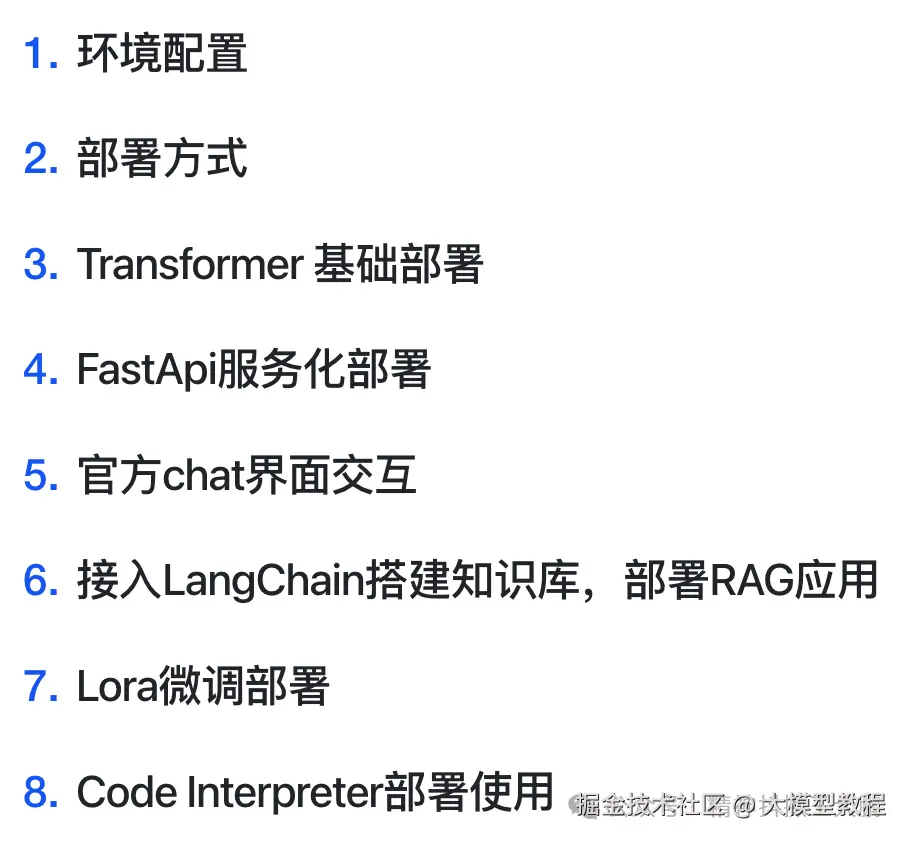
环境配置
-
- 模型选择:ChatGLM3-6B,模型大小14G,支持多种部署方式(Transformer、FastAPI、Web界面等),且在self-LLM项目中近期有更新
-
- 部署平台:AutoML,环境配置4090单卡24G显寸
-
- 镜像选择:pytorch 2.1.0+python 3.10+cuda 12.1
部署方式
为方便管理各个模块的版本,我们采用uv方式进行部署:
-
- 安装uv
bash
curl -LsSf https://astral.sh/uv/install.sh | shsource $HOME/.cargo/env-
- 创建项目环境
bash
mkdir -p /root/autodl-tmp/chatglm && cd /root/autodl-tmp/chatglm-
- 初始化虚拟环境
css
uv venv --python 3.10 chatglm-env-
- 激活虚拟环境
bash
source chatglm-env/bin/activate-
- 安装requirements.txt
bash
# AutoDL开启镜像加速
source /etc/network_turbo
# 一键安装
uv pip install -r requirements.txtrequirements.txt见git仓库:
https://github.com/ditingdapeng/12Days-LLM-Application/tree/main/3
Transformer 基础部署
-
- 切换ipykernel,打开jupyter,切换内核ipykernel,选择我们新创建的环境
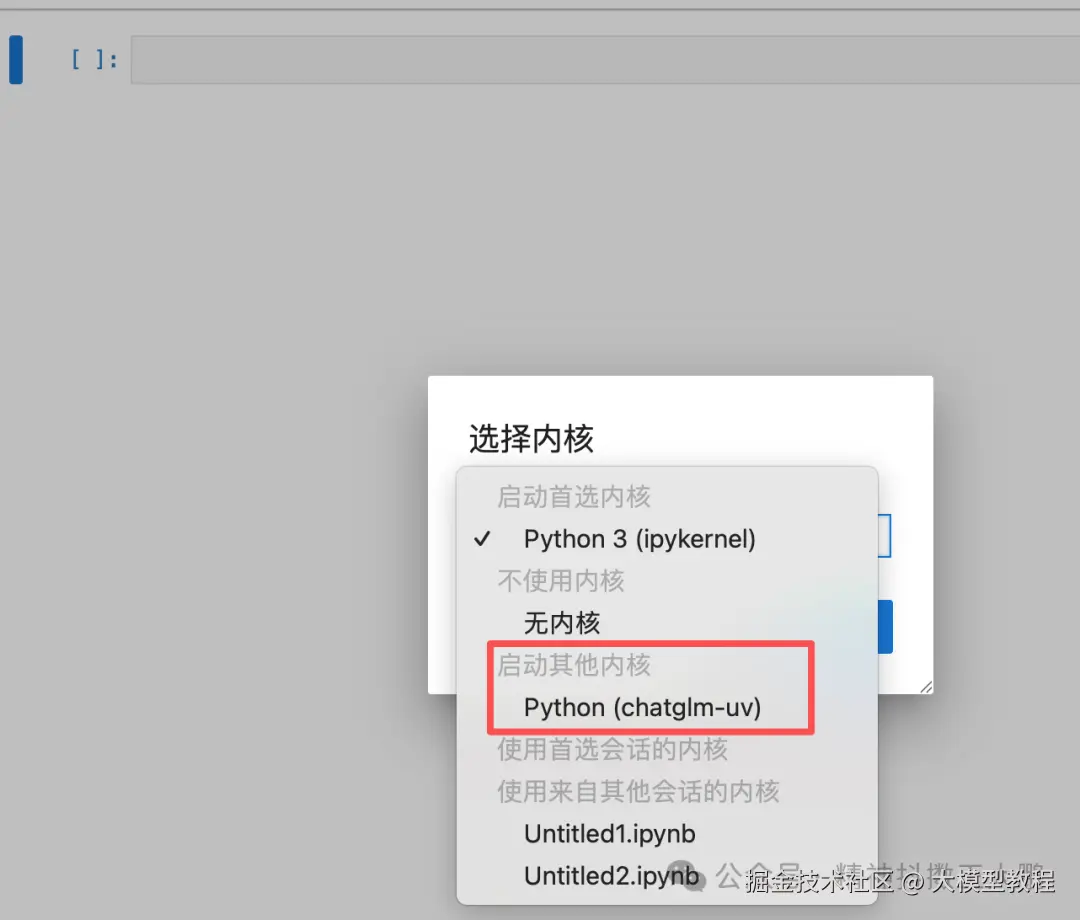
-
- 模型下载
模型大小为14GB,开镜像加速后下载。
- 模型下载
java
import torch
from modelscope import snapshot_download, AutoModel, AutoTokenizer
import os
model_dir = snapshot_download('ZhipuAI/chatglm3-6b', cache_dir='/root/autodl-tmp', revision='master')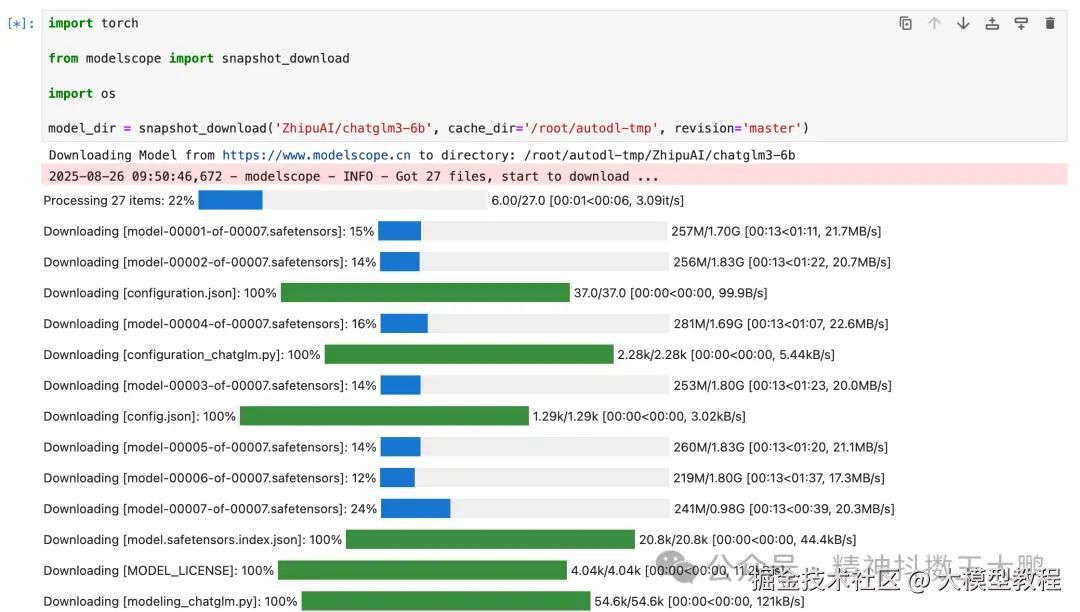
-
- 导入库和配置
python
# 使用Hugging Face中'transformer'库中的AutoTokenizer和AutoModelForCausalLM以加载分词器和对话模型
from transformers import AutoTokenizer, AutoModelForCausalLM
import torch
# 使用模型下载到的本地路径以加载
model_dir = '/root/autodl-tmp/ZhipuAI/chatglm3-6b'
print(f"模型路径: {model_dir}")-
- 加载分词器和模型
python
# 分词器的加载,本地加载,trust_remote_code=True设置允许从网络上下载模型权重和相关的代码
print("正在加载分词器...")
tokenizer = AutoTokenizer.from_pretrained(model_dir, trust_remote_code=True)
# 模型加载,本地加载,使用AutoModelForCausalLM类
print("正在加载模型...")
model = AutoModelForCausalLM.from_pretrained(model_dir, trust_remote_code=True)
# 将模型移动到GPU上进行加速(如果有GPU的话)
device = torch.device("cuda"if torch.cuda.is_available() else"cpu")
print(f"使用设备: {device}")
model.to(device)
# 使用模型的评估模式来产生对话
model.eval()
print("模型加载完成!")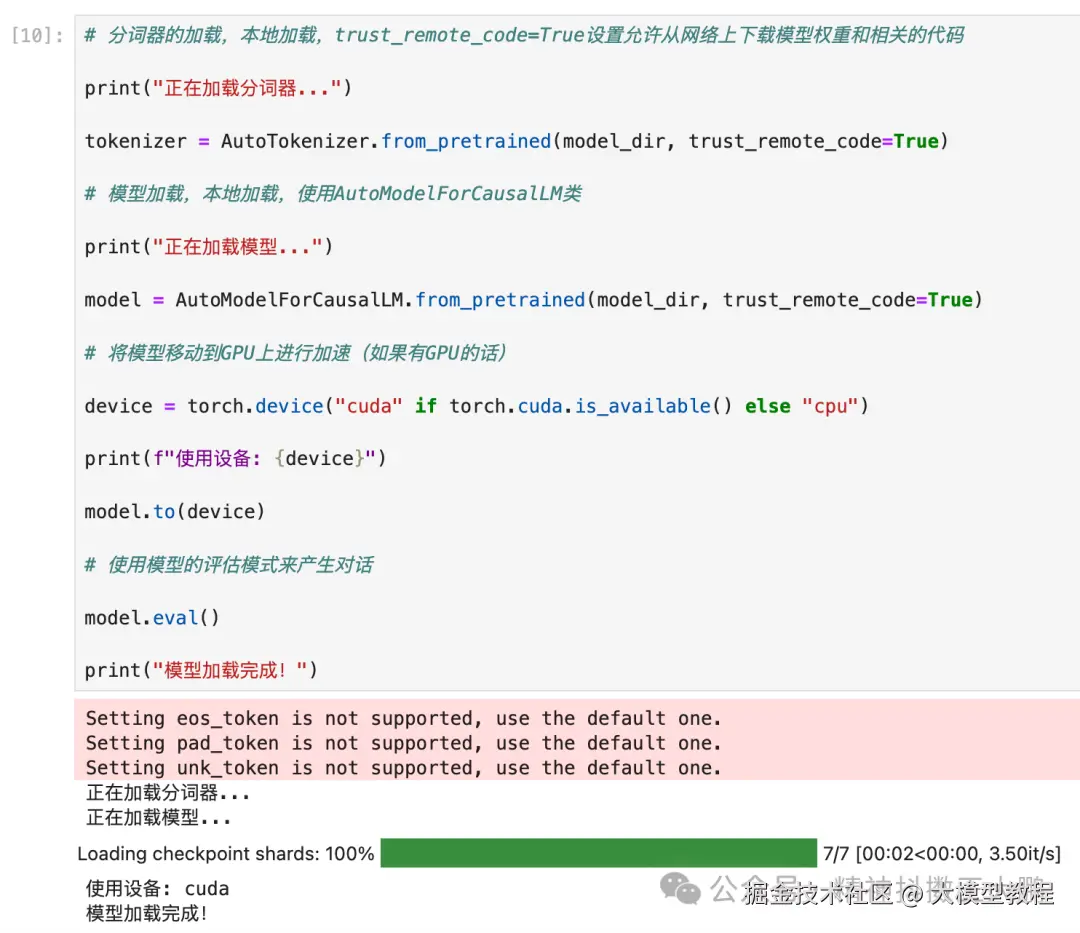
-
- 对话测试
bash
# 第一轮对话
print("=== 第一轮对话 ===")
response, history = model.chat(tokenizer, "你好", history=[])
print(f"用户: 你好")
print(f"ChatGLM: {response}")
print()
# 第二轮对话
print("=== 第二轮对话 ===")
response, history = model.chat(tokenizer, "请介绍一下你自己", history=history)
print(f"用户: 请介绍一下你自己")
print(f"ChatGLM: {response}")
print()
# 第三轮对话
print("=== 第三轮对话 ===")
response, history = model.chat(tokenizer, "请帮我使用python语言写一段冒泡排序的代码", history=history)
print(f"用户: 请帮我使用python语言写一段冒泡排序的代码")
print(f"ChatGLM: {response}")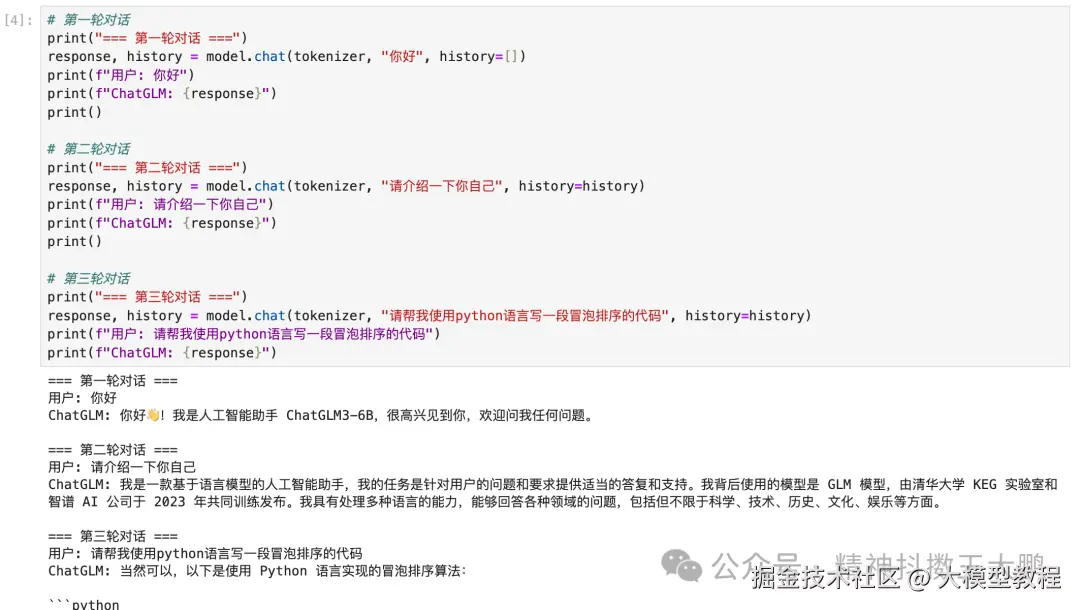
FastApi服务化部署
通过FastAPI部署,让本地的ChatGLM3-6B模型变成一个服务,可以被任何支持HTTP的客户端调用,这样其他系统只需要通过HTTP接口,就可以有使用AI的能力。
在AutoDL里,通过终端运行服务:
ini
# api.py
from fastapi import FastAPI, Request
from transformers import AutoTokenizer, AutoModelForCausalLM
import uvicorn
import json
import datetime
import torch
# 设置设备参数
DEVICE = "cuda"
DEVICE_ID = "0"
CUDA_DEVICE = f"{DEVICE}:{DEVICE_ID}"if DEVICE_ID else DEVICE
# 创建FastAPI应用
app = FastAPI()
# 处理POST请求的端点
@app.post("/")
asyncdefcreate_item(request: Request):
global model, tokenizer
json_post_raw = await request.json()
json_post = json.dumps(json_post_raw)
json_post_list = json.loads(json_post)
prompt = json_post_list.get('prompt')
history = json_post_list.get('history')
max_length = json_post_list.get('max_length')
top_p = json_post_list.get('top_p')
temperature = json_post_list.get('temperature')
# 调用模型进行对话生成
response, history = model.chat(
tokenizer,
prompt,
history=history,
max_length=max_length if max_length else2048,
top_p=top_p if top_p else0.7,
temperature=temperature if temperature else0.95
)
now = datetime.datetime.now()
time = now.strftime("%Y-%m-%d %H:%M:%S")
# 构建响应JSON
answer = {
"response": response,
"history": history,
"status": 200,
"time": time
}
# 构建日志信息
log = "[" + time + "] " + '", prompt:"' + prompt + '", response:"' + repr(response) + '"'
print(log)
return answer
# 主函数入口
if __name__ == '__main__':
# 加载预训练的分词器和模型 - PyTorch 2.0优化版本
tokenizer = AutoTokenizer.from_pretrained(
"/root/autodl-tmp/ZhipuAI/chatglm3-6b",
trust_remote_code=True
)
model = AutoModelForCausalLM.from_pretrained(
"/root/autodl-tmp/ZhipuAI/chatglm3-6b",
trust_remote_code=True,
torch_dtype=torch.float16, # PyTorch 2.0对float16支持更好
device_map="auto"# 利用PyTorch 2.0的自动设备映射
)
model.eval() # 设置模型为评估模式
# 启动FastAPI应用
uvicorn.run(app, host='0.0.0.0', port=6006, workers=1)在uv环境下运行上面的代码,并新起一个终端做测试,看回复效果:
vbnet
curl -X POST http://localhost:6006 -H "Content-Type: application/json" -d '{
"prompt": "你好",
"history": [],
"max_length": 2048,
"top_p": 0.7,
"temperature": 0.95
}'
服务返回的状态如下:

官方chat界面交互
在学习了基础的 Transformer 模型调用和 FastAPI 服务部署之后,我们可以进一步体验官方提供的交互式 Chat 界面。在 ChatGLM3 的官方示例 中,提供了两种主流的轻量级 Web 交互方案:
- • web_demo_gradio.py(基于 Gradio)
- • web_demo_streamlit.py(基于 Streamlit)
这两种框架都支持快速构建模型前端界面,适合本地调试与演示。本例中我们以 Streamlit 为例进行部署,因其布局灵活,适合构建功能丰富的交互界面。通常我们在做应用时,可以参考官网提供的代码,来寻找最佳实践。
由于需要在 AutoDL 平台上从外部访问服务,我们可通过端口 6006 进行服务映射,实现 Web 界面的远程访问。
- clone该项目,修改模型路径到本地
bash
git clone https://github.com/THUDM/ChatGLM3.git
cd ChatGLM3/basic_demo
vim web_demo_streamlit.py 2.MODEL_PATH和TOKENIZER_PATH设为
/root/autodl-tmp/ZhipuAI/chatglm3-6b

- 运行启动该streamlit应用:
css
streamlit run web_demo_streamlit.py --server.address 127.0.0.1 --server.port 6006
在AutoDL中,需要通过实例的自定义服务,把接口映射到本地,具体操作参考如下步骤:
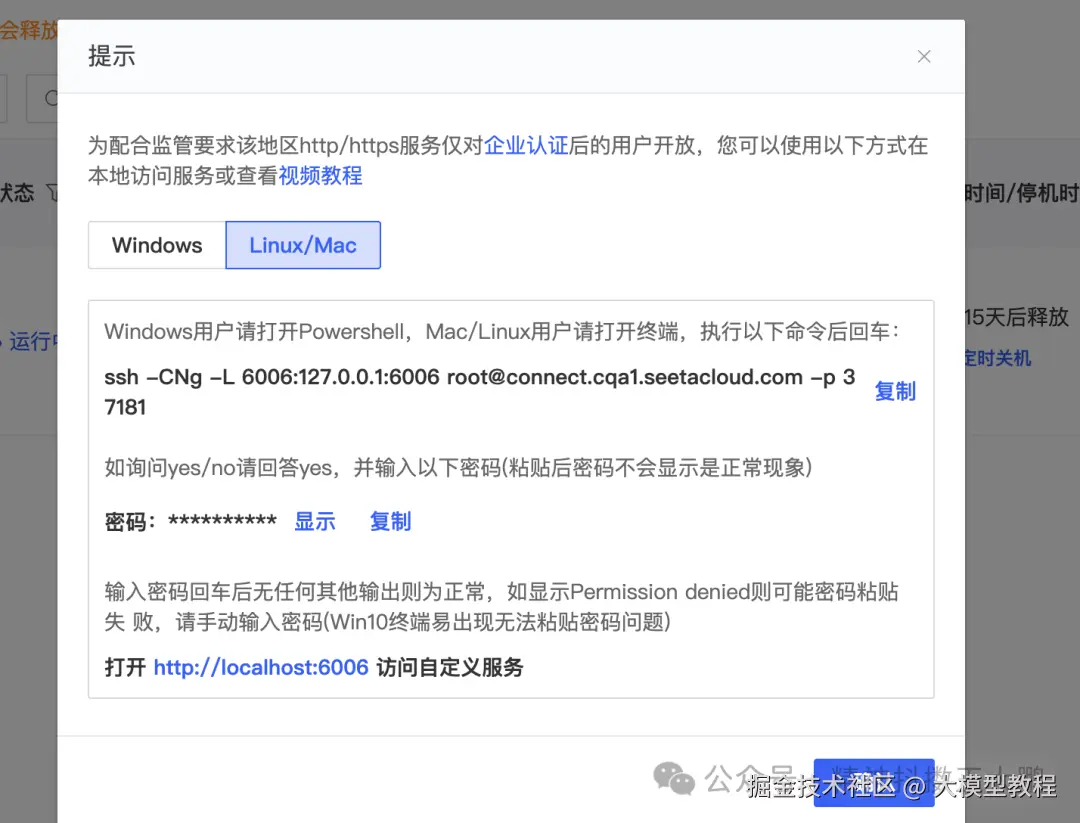
在本地通过http://localhost:6006访问demo,效果如下:

接入LangChain搭建知识库,部署RAG应用
无论是FastAPI部署还是刚才的Streamlit web交互,ChatGLM3-6B都只能基于它的 预训练知识 来回答问题。但如果我想让它回答关于我们公司内部文档、最新技术资料或者特定领域知识的问题呢?
这就需要用到RAG(Retrieval-Augmented Generation) ,简单来说,就是"检索增强生成"------先从知识库中检索相关信息,再让大模型基于这些信息生成回答。接下来,本小节将构建一个完整的知识库助手,基于Sentence Transformer和Chroma向量数据库构建语料库,并将ChatGLM3-6B接入LangChain框架实现完整的RAG流程。
- 下载语料库内容
到数据存储目录中,下载知识库源码:
bash
cd /root/autodl-tmp
# 下载所有知识库源码
git clone https://github.com/datawhalechina/self-llm.git
git clone https://github.com/datawhalechina/llm-universe.git
git clone https://github.com/datawhalechina/prompt-engineering-for-developers.git
git clone https://github.com/datawhalechina/so-large-lm.git
git clone https://github.com/datawhalechina/hugging-llm.git
- 环境验证测试
python
# 完整的ChatGLM3-6B LangChain集成测试
import sys
print(f"Python版本: {sys.version}")
try:
# 核心依赖测试
from sentence_transformers import SentenceTransformer
from huggingface_hub import cached_download
from langchain.embeddings.huggingface import HuggingFaceEmbeddings
from langchain.vectorstores import Chroma
from langchain.chains import RetrievalQA
from langchain.text_splitter import RecursiveCharacterTextSplitter
print("✅ 所有核心组件导入成功!")
# 测试实际功能
embeddings = HuggingFaceEmbeddings(
model_name="/root/autodl-tmp/sentence-transformer"
)
print("✅ 向量化模型加载成功!")
print("🎉 ChatGLM3-6B LangChain环境配置完成!")
except Exception as e:
print(f"❌ 错误详情: {e}")
import traceback
traceback.print_exc()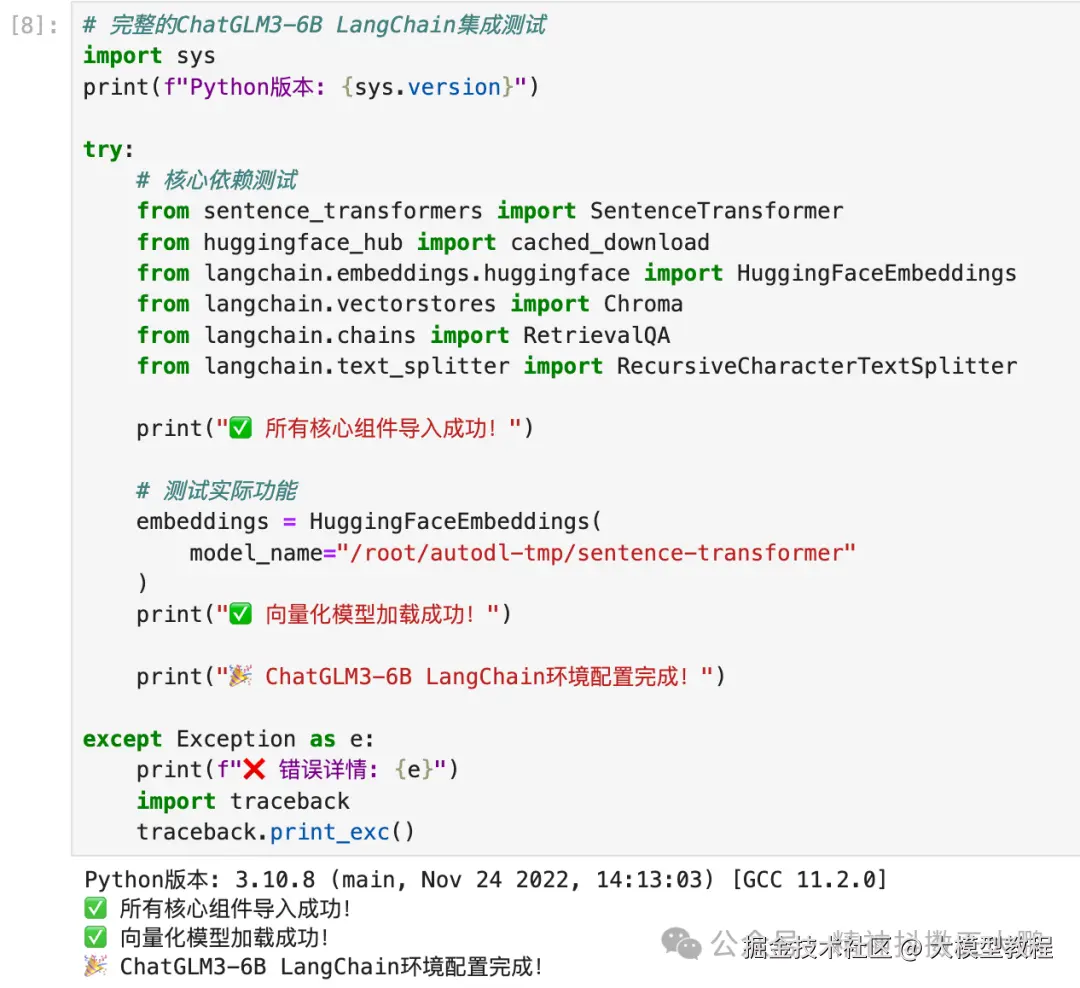
3.下载Sentence-Transformer模型,用于向量化数据库
bash
# 创建向量模型目录
mkdir -p /root/autodl-tmp/sentence-transformer
cd /root/autodl-tmp
# 下载多语言向量模型
modelscope download --model=sentence-transformers/paraphrase-multilingual-MiniLM-L12-v2 --local_dir=./sentence-transformer4.创建向量数据库
python
# dbinit.py
# 首先导入所需第三方库
from langchain.document_loaders import UnstructuredFileLoader
from langchain.document_loaders import UnstructuredMarkdownLoader
from langchain.text_splitter import RecursiveCharacterTextSplitter
from langchain.vectorstores import Chroma
from langchain.embeddings.huggingface import HuggingFaceEmbeddings
from langchain.schema import Document
from tqdm import tqdm
import os
import chardet
# 获取文件路径函数
defget_files(dir_path):
file_list = []
for filepath, dirnames, filenames in os.walk(dir_path):
for filename in filenames:
if filename.endswith(".md") or filename.endswith(".txt"):
file_list.append(os.path.join(filepath, filename))
return file_list
# 检测文件编码
defdetect_encoding(file_path):
withopen(file_path, 'rb') as f:
raw_data = f.read(10000) # 读取前10KB用于检测
result = chardet.detect(raw_data)
return result['encoding']
# 安全读取文件内容
defsafe_read_file(file_path):
encodings = ['utf-8', 'gbk', 'gb2312', 'latin-1', 'cp1252']
for encoding in encodings:
try:
withopen(file_path, 'r', encoding=encoding) as f:
content = f.read()
return content, encoding
except UnicodeDecodeError:
continue
except Exception as e:
print(f"读取文件 {file_path} 时出错: {e}")
continue
# 如果所有编码都失败,尝试自动检测
try:
detected_encoding = detect_encoding(file_path)
if detected_encoding:
withopen(file_path, 'r', encoding=detected_encoding) as f:
content = f.read()
return content, detected_encoding
except:
pass
returnNone, None
# 改进的文件加载函数
defget_text_robust(dir_path):
file_lst = get_files(dir_path)
docs = []
failed_files = []
print(f"\n开始处理文件夹: {dir_path}")
print(f"找到 {len(file_lst)} 个文件")
for one_file in tqdm(file_lst, desc=f"处理 {os.path.basename(dir_path)}"):
try:
file_type = one_file.split('.')[-1]
# 首先尝试使用原始加载器
try:
if file_type == 'md':
loader = UnstructuredMarkdownLoader(one_file)
elif file_type == 'txt':
loader = UnstructuredFileLoader(one_file)
else:
continue
docs.extend(loader.load())
except UnicodeDecodeError:
# 如果编码错误,使用安全读取方法
print(f"\n编码错误,尝试安全读取: {one_file}")
content, encoding = safe_read_file(one_file)
if content:
docs.append(Document(
page_content=content,
metadata={"source": one_file, "encoding": encoding}
))
print(f"成功读取,使用编码: {encoding}")
else:
failed_files.append(one_file)
print(f"跳过文件: {one_file}")
except Exception as e:
failed_files.append(one_file)
print(f"\n处理文件失败: {one_file}, 错误: {e}")
continue
print(f"\n文件夹 {dir_path} 处理完成:")
print(f"- 成功处理: {len(file_lst) - len(failed_files)} 个文件")
print(f"- 失败文件: {len(failed_files)} 个")
if failed_files:
print("失败文件列表:")
for f in failed_files[:5]: # 只显示前5个
print(f" - {f}")
iflen(failed_files) > 5:
print(f" - ... 还有 {len(failed_files) - 5} 个文件")
return docs
# 目标文件夹
tar_dir = [
"/root/autodl-tmp/self-llm",
"/root/autodl-tmp/llm-universe",
"/root/autodl-tmp/prompt-engineering-for-developers",
"/root/autodl-tmp/so-large-lm",
"/root/autodl-tmp/hugging-llm",
]
# 加载目标文件
docs = []
for i, dir_path inenumerate(tar_dir):
print(f"\n=== 处理第 {i+1}/{len(tar_dir)} 个文件夹 ===")
try:
folder_docs = get_text_robust(dir_path)
docs.extend(folder_docs)
print(f"累计文档数量: {len(docs)}")
except Exception as e:
print(f"处理文件夹 {dir_path} 时出错: {e}")
continue
print(f"\n=== 文档加载完成 ===")
print(f"总文档数量: {len(docs)}")
# 对文本进行分块
print("\n开始文本分块...")
text_splitter = RecursiveCharacterTextSplitter(
chunk_size=500, chunk_overlap=150)
split_docs = text_splitter.split_documents(docs)
print(f"分块后文档数量: {len(split_docs)}")
# 加载开源词向量模型
print("\n加载词向量模型...")
embeddings = HuggingFaceEmbeddings(model_name="/root/autodl-tmp/sentence-transformer")
# 构建向量数据库
print("\n构建向量数据库...")
persist_directory = 'data_base/vector_db/chroma'
vectordb = Chroma.from_documents(
documents=split_docs,
embedding=embeddings,
persist_directory=persist_directory
)
# 持久化
vectordb.persist()
print("\n=== 向量数据库构建完成! ===")
print(f"数据库位置: {persist_directory}")
print(f"处理的文档数量: {len(docs)}")
print(f"向量化的文本块数量: {len(split_docs)}")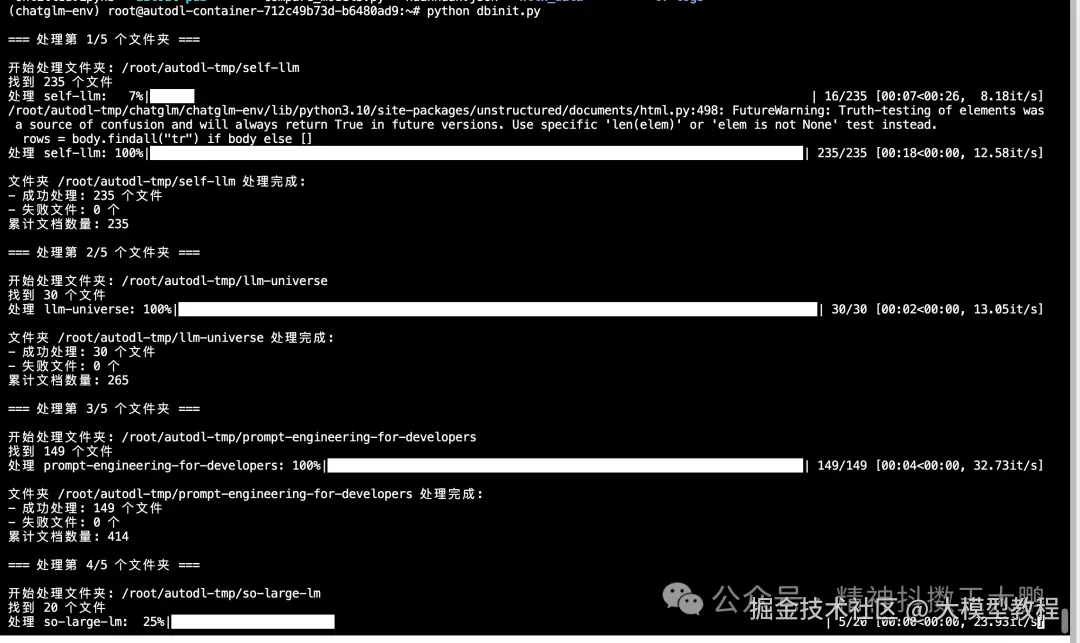
最终共加载了450个文档、25768个文本块,平均每个文档被分割成约57个文本块,设置的chunk_size=500, chunk_overlap=150,这个配置适合文本快的检索,不至于过大或过小。
Failed to send telemetry event只是ChromaDB尝试发送使用统计信息时的版本兼容问题告警,重要的是向量数据库本身工作正常。
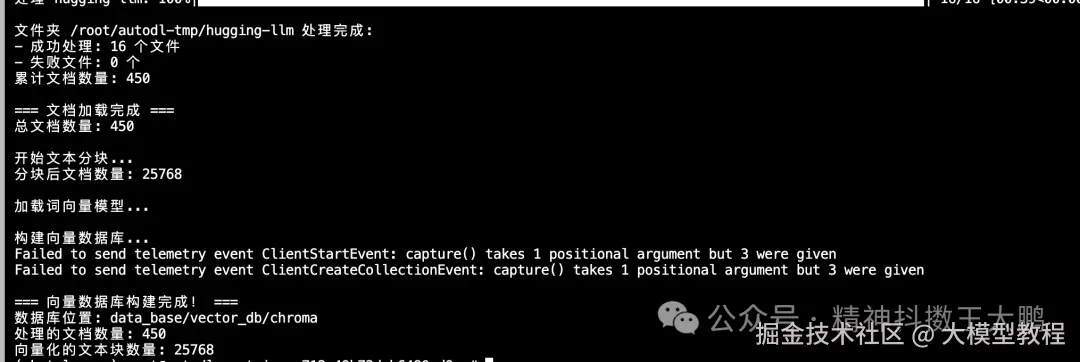
5.ChatGLM接入LangChain
LangChain是一个框架,它要求所有 LLM 必须遵循统一的接口规范,使大模型(本例为ChatGLM)能够作为标准组件,参与提示工程、记忆管理、检索增强、智能代理等高级流程。
我们先通过统一的LLM类,实现ChatGLM的LangChain封装:
python
# LLM.py
from langchain.llms.base import LLM
from typing importAny, List, Optional
from langchain.callbacks.manager import CallbackManagerForLLMRun
from transformers import AutoTokenizer, AutoModelForCausalLM
import torch
classChatGLM_LLM(LLM):
# 基于本地 ChatGLM 自定义 LLM 类
tokenizer : AutoTokenizer = None
model: AutoModelForCausalLM = None
def__init__(self, model_path :str):
# model_path: ChatGLM 模型路径
# 从本地初始化模型
super().__init__()
print("正在从本地加载模型...")
self.tokenizer = AutoTokenizer.from_pretrained(model_path, trust_remote_code=True)
self.model = AutoModelForCausalLM.from_pretrained(model_path, trust_remote_code=True).to(torch.bfloat16).cuda()
self.model = self.model.eval()
print("完成本地模型的加载")
def_call(self, prompt : str, stransform: translateY( Optional[List[str]] = None,
run_manager: Optional[CallbackManagerForLLMRun] = None,
**kwargs: Any):
# 重写调用函数
response, history = self.model.chat(self.tokenizer, prompt , history=[])
return response
@property
def_llm_type(self) -> str:
return "ChatGLM3-6B"验证ChatGLM是否做了向量知识库的增强,和LLM.py放在同目录下:
python
# test_qa_chain.py
from langchain.vectorstores import Chroma
from langchain.embeddings.huggingface import HuggingFaceEmbeddings
from LLM import ChatGLM_LLM
from langchain.prompts import PromptTemplate
from langchain.chains import RetrievalQA
import os
defload_chain():
"""加载检索问答链"""
print("正在加载向量数据库...")
# 定义 Embeddings
embeddings = HuggingFaceEmbeddings(model_name="/root/autodl-tmp/sentence-transformer")
# 向量数据库持久化路径
persist_directory = 'data_base/vector_db/chroma'
# 加载数据库
vectordb = Chroma(
persist_directory=persist_directory,
embedding_function=embeddings
)
print("正在加载ChatGLM模型...")
# 加载自定义 LLM
llm = ChatGLM_LLM(model_path="/root/autodl-tmp/ZhipuAI/chatglm3-6b")
# 定义 Prompt Template
template = """使用以下上下文来回答最后的问题。如果你不知道答案,就说你不知道,不要试图编造答案。尽量使答案简明扼要。总是在回答的最后说"谢谢你的提问!"。
{context}
问题: {question}
有用的回答:"""
QA_CHAIN_PROMPT = PromptTemplate(input_variables=["context","question"],template=template)
# 构建检索问答链
qa_chain = RetrievalQA.from_chain_type(
llm,
retriever=vectordb.as_retriever(),
return_source_documents=True,
chain_type_kwargs={"prompt":QA_CHAIN_PROMPT}
)
return qa_chain
deftest_qa_chain():
"""测试检索问答链效果"""
# 加载问答链
qa_chain = load_chain()
# 测试问题
questions = [
"什么是 Self LLM?",
"ChatGLM3-6B 有什么特点?",
"如何部署 ChatGLM 模型?"
]
print("\n=== 开始测试检索问答链 ===")
for i, question inenumerate(questions, 1):
print(f"\n--- 测试问题 {i} ---")
print(f"问题:{question}")
# 检索问答链回答
result = qa_chain({"query": question})
print(f"检索问答链回答:{result['result']}")
# 显示检索到的相关文档数量
print(f"检索到相关文档数量:{len(result['source_documents'])}")
print("-" * 50)
if __name__ == "__main__":
test_qa_chain()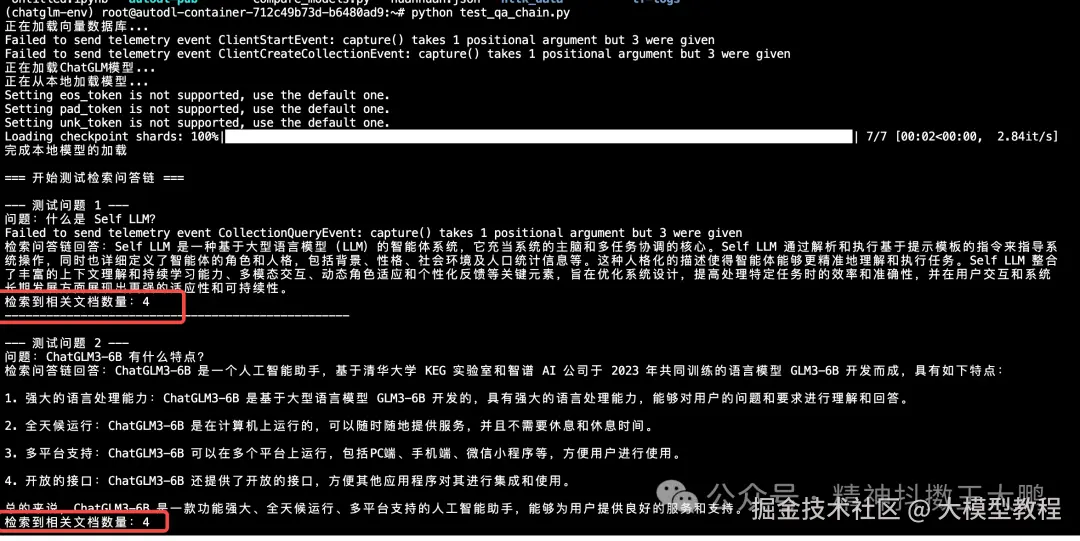
Lora微调部署
微调技术是个很重要的技能,举个例子,腾讯动漫中有一个漫画角色AI助手,让用户可以直接与漫画角色做对话。如果我们使用原版ChatGLM3-6B模型来做,模型依然只记住自己是ChatGLM3-6B,而不是自己是某个角色的设定。
我们需要只训练一小部分新增的参数,更新该模型的设定,可以用Lora(Low-Rank Adaptation)来构建个性化风格的LLM。
1.下载训练数据集
格式为:instruction-input-output三元结构(参考Self-Instruct论文)
ruby
wget https://raw.githubusercontent.com/datawhalechina/self-llm/master/dataset/huanhuan.json2.训练LoRA权重
ini
# lora_finetune.py
import torch
from datasets import Dataset
from transformers import AutoTokenizer, AutoModelForCausalLM, DataCollatorForSeq2Seq, TrainingArguments, Trainer
import pandas as pd
from peft import TaskType, get_peft_model, LoraConfig
import json
import os
# 数据处理函数
defprocess_func(example):
MAX_LENGTH = 512
input_ids, labels = [], []
instruction_text = "\n".join([
"<|system|>",
"现在你要扮演皇帝身边的女人--甄嬛",
"<|user|>",
example["instruction"] + example["input"] + "<|assistant|>"
]).strip() + "\n"
instruction = tokenizer(
instruction_text,
add_special_tokens=True,
truncation=True,
max_length=MAX_LENGTH,
return_tensors=None
)["input_ids"]
response = tokenizer(
example["output"],
add_special_tokens=False,
truncation=True,
max_length=MAX_LENGTH,
return_tensors=None
)["input_ids"]
input_ids = instruction + response + [tokenizer.eos_token_id]
labels = [tokenizer.pad_token_id] * len(instruction) + response + [tokenizer.eos_token_id]
# 确保长度一致
iflen(input_ids) > MAX_LENGTH:
input_ids = input_ids[:MAX_LENGTH]
labels = labels[:MAX_LENGTH]
else:
pad_len = MAX_LENGTH - len(input_ids)
input_ids += [tokenizer.pad_token_id] * pad_len
labels += [tokenizer.pad_token_id] * pad_len
labels = [(l if l != tokenizer.pad_token_id else -100) for l in labels]
return {
"input_ids": input_ids,
"labels": labels
}
# 🔥 修改训练参数配置 - 更新保存路径
args = TrainingArguments(
output_dir="/root/output/ChatGLM-Lora", # 🔥 修改为指定路径
per_device_train_batch_size=1, # 增加批次大小
gradient_accumulation_steps=8,
logging_steps=10,
num_train_epochs=3, # 增加到3个epoch
learning_rate=2e-4, # 稍微提高学习率
save_steps=100,
save_total_limit=2,
dataloader_pin_memory=False,
remove_unused_columns=False
)
if __name__ == "__main__":
print("🚀 开始ChatGLM3-6B Lora微调...")
# 1. 加载数据集
print("📊 加载数据集...")
df = pd.read_json('./huanhuan.json')
ds = Dataset.from_pandas(df)
print(f"数据集大小: {len(ds)}")
# 2. 加载tokenizer
print("🔤 加载tokenizer...")
tokenizer = AutoTokenizer.from_pretrained(
"/root/autodl-tmp/ZhipuAI/chatglm3-6b",
trust_remote_code=True
)
# 3. 数据预处理
print("⚙️ 数据预处理...")
tokenized_ds = ds.map(process_func, remove_columns=ds.column_names)
# 4. 加载模型
print("🤖 加载ChatGLM3-6B模型...")
model = AutoModelForCausalLM.from_pretrained(
"/root/autodl-tmp/ZhipuAI/chatglm3-6b",
torch_dtype=torch.half,
trust_remote_code=True,
low_cpu_mem_usage=True
)
# 5. 创建LoRA参数
print("🔧 配置LoRA参数...")
config = LoraConfig(
task_type=TaskType.CAUSAL_LM,
target_modules=["query_key_value", "dense", "dense_h_to_4h", "dense_4h_to_h"], # 更多模块
r=16,
lora_alpha=32,
lora_dropout=0.1
)
# 6. 模型合并
print("🔗 应用LoRA适配器...")
model = get_peft_model(model, config)
# 确保LoRA参数可训练
model.train()
for name, param in model.named_parameters():
if'lora'in name.lower():
param.requires_grad = True
print(f"✅ 激活LoRA参数: {name}")
# 打印可训练参数统计
model.print_trainable_parameters()
# 7. 配置数据整理器
data_collator = DataCollatorForSeq2Seq(
tokenizer,
model=model,
label_pad_token_id=-100,
pad_to_multiple_of=None,
padding=True,
return_tensors="pt"
)
# 8. 创建训练器
print("🏃 创建训练器...")
trainer = Trainer(
model=model,
args=args,
train_dataset=tokenized_ds,
data_collator=data_collator,
)
# 9. 开始训练
print("🎯 开始训练...")
trainer.train()
# 10. 保存模型 - 🔥 增强版保存逻辑
print("💾 保存LoRA权重...")
# 确保目录存在
save_path = "/root/output/ChatGLM-Lora"
os.makedirs(save_path, exist_ok=True)
# 保存LoRA权重
trainer.save_model(save_path)
# 直接使用model.save_pretrained确保保存成功
model.save_pretrained(save_path)
# 验证保存是否成功
required_files = ["adapter_config.json", "adapter_model.bin"]
all_files_exist = all(os.path.exists(os.path.join(save_path, f)) for f in required_files)
if all_files_exist:
print(f"✅ LoRA权重已成功保存到: {save_path}")
print(f"📁 保存的文件:")
for file in os.listdir(save_path):
file_path = os.path.join(save_path, file)
file_size = os.path.getsize(file_path)
print(f" - {file} ({file_size} bytes)")
else:
print("❌ 保存失败!缺少必要文件:")
for f in required_files:
ifnot os.path.exists(os.path.join(save_path, f)):
print(f" ❌ 缺少: {f}")
print("✅ 微调完成!")
3.加载Lora权重测试效果:
ini
# lora_models.py
from transformers import AutoTokenizer, AutoModelForCausalLM
from peft import PeftModel
import torch
# 加载基础模型和tokenizer
model = AutoModelForCausalLM.from_pretrained("/root/autodl-tmp/ZhipuAI/chatglm3-6b",
trust_remote_code=True,
low_cpu_mem_usage=True,
torch_dtype=torch.half,
device_map="auto")
tokenizer = AutoTokenizer.from_pretrained("/root/autodl-tmp/ZhipuAI/chatglm3-6b",
use_fast=False,
trust_remote_code=True)
# 加载LoRA权重
p_model = PeftModel.from_pretrained(model, model_id="/root/output/ChatGLM-Lora")
# 测试函数
deftest_model(question):
# 按照训练时的格式构造输入
prompt = "<|system|>\n现在你要扮演皇帝身边的女人--甄嬛\n<|user|>\n{}\n<|assistant|>\n".format(question)
inputs = tokenizer(prompt, return_tensors="pt").to(p_model.device)
with torch.no_grad():
outputs = p_model.generate(
**inputs,
max_length=128,
do_sample=True,
temperature=0.7,
top_p=0.9,
pad_token_id=tokenizer.eos_token_id
)
response = tokenizer.decode(outputs[0], skip_special_tokens=True)
return response
# 测试问题
test_questions = [
"你是谁?",
"你的父亲是谁?",
"你觉得皇上怎么样?",
"你最喜欢什么?"
]
print("=== LoRA微调后的甄嬛模型测试 ===")
for question in test_questions:
print(f"\n问题: {question}")
answer = test_model(question)
print(f"甄嬛: {answer.split('<|assistant|>')[-1].strip()}")
注:受限于数据盘大小,Prompt也会对效果起到影响,更好的效果可以在自行训练中加深训练轮次。
Code Interpreter部署使用
想象一下,如果ChatGLM不仅能帮你写代码,还能直接运行这些代码并给你结果,这会带来什么样的体验?
当你使用ChatGLM普通模式,问"帮我计算1到100的和",模型会返回代码sum(range(1,101)), 而当你使用Code Interpreter模式,问同样问题,模型不仅返回代码,还执行代码,最终直接告诉你结果是:5050。
那么通过Interpreter,就可以完成程序的自动调试和修正,而非一次次的输入交互做重试。
下面我们通过官方的demo做使用,在前面的步骤中已经clone了ChatGLM3仓库代码,所以这里我们之间进入:
bash
cd /root/autodl-tmp/ChatGLM3/composite_demo设置环境变量:
bash
export MODEL_PATH=/root/autodl-tmp/ZhipuAI/chatglm3-6b
export IPYKERNEL=python3依旧使用streamlit启动6006的服务:
css
streamlit run main.py --server.port 6006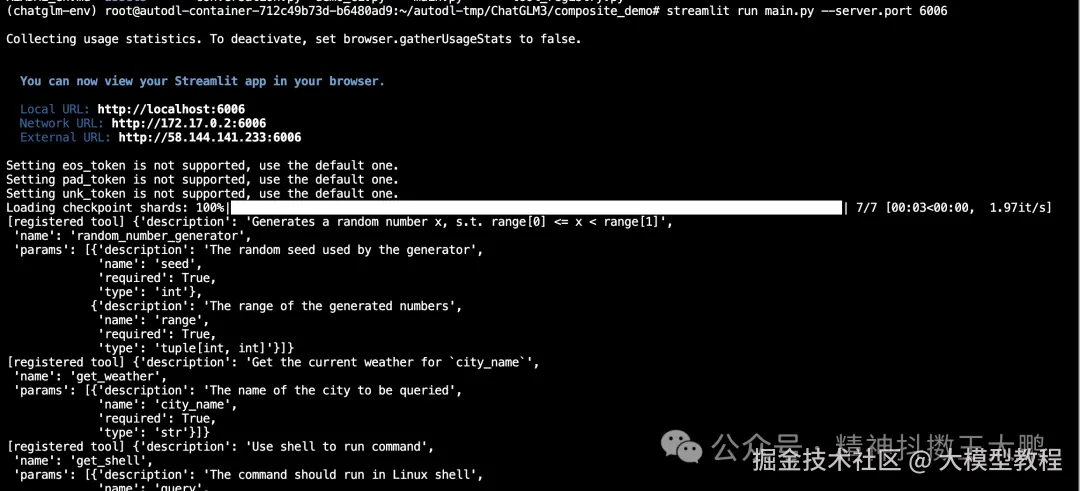
运行界面为:
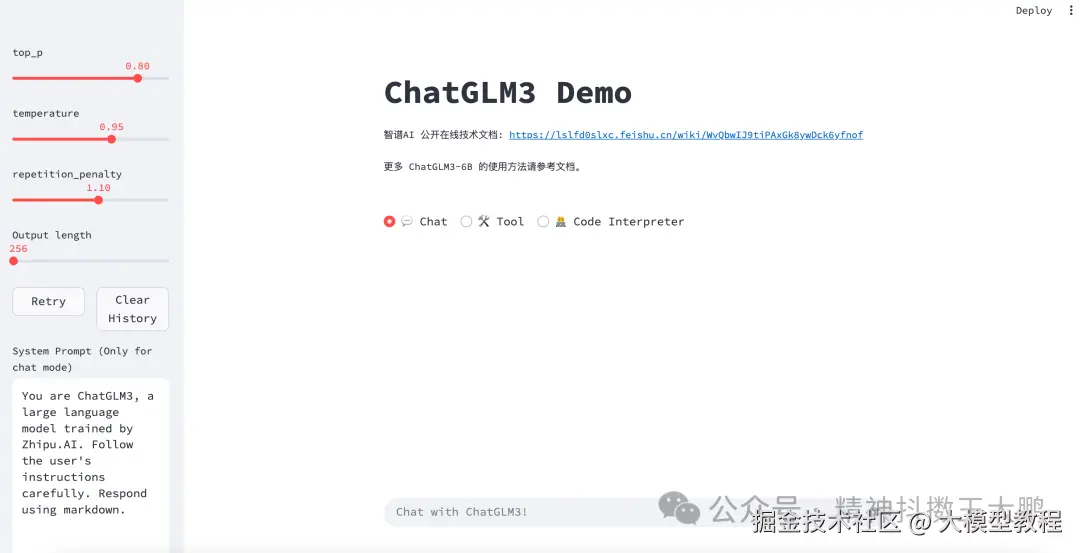
切换为Code Interpreter模式做提问,可以运行代码生成结果:
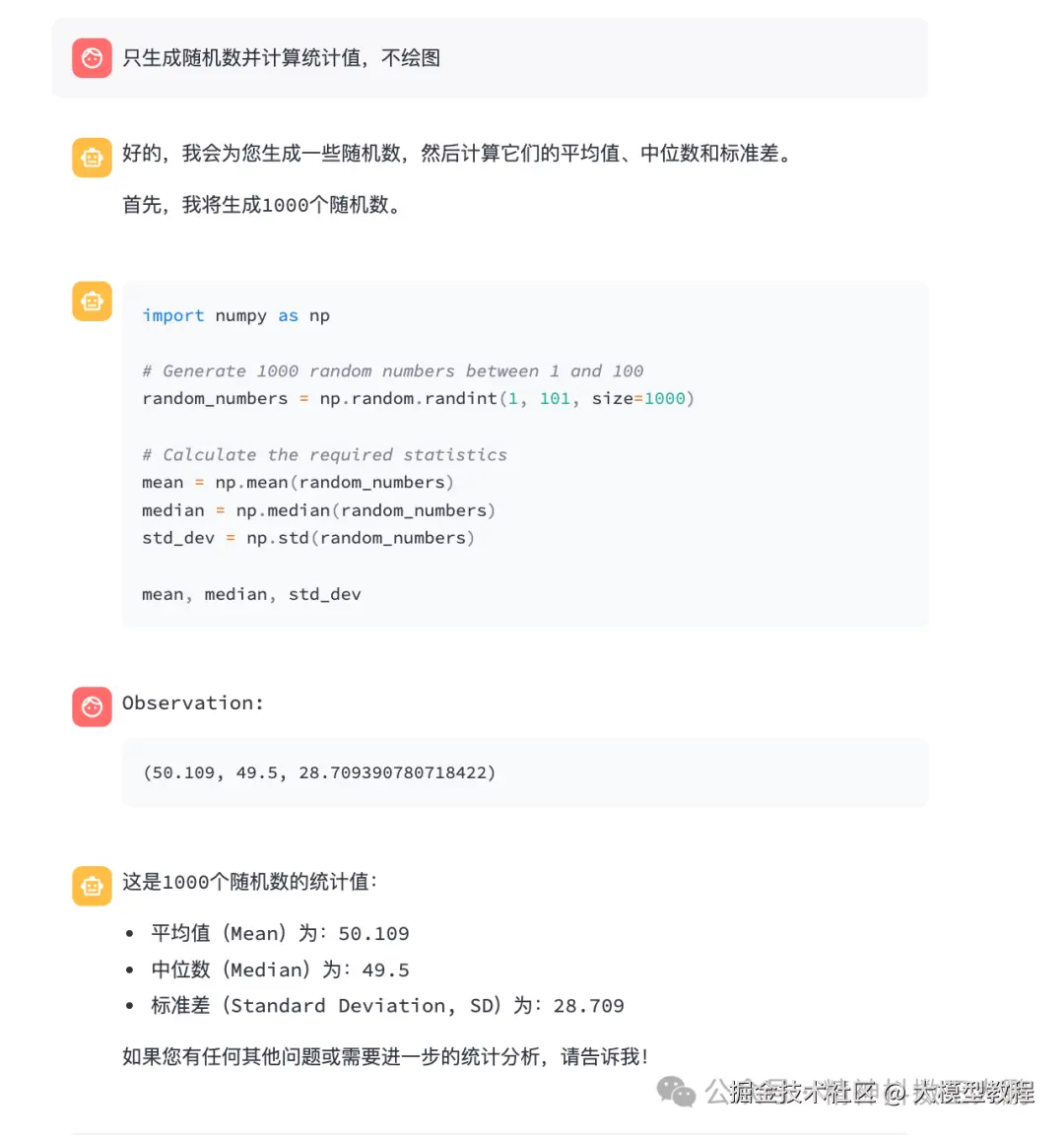
参考:1. self-llm github.com/datawhalech...